Presynaptic Inhibition of Primary Nociceptive Signals to Dorsal Horn Lamina I Neurons by Dopamine
- PMID: 30143577
- PMCID: PMC6596087
- DOI: 10.1523/JNEUROSCI.0323-18.2018
Presynaptic Inhibition of Primary Nociceptive Signals to Dorsal Horn Lamina I Neurons by Dopamine
Abstract
The dorsal horn of the spinal cord represents the first relay station in the pain pathway where primary nociceptive inputs are modulated by local circuits and by descending signals before being relayed to supraspinal nuclei. To determine whether dopamine can modulate primary nociceptive Aδ- and C-fiber signals, the effects of dopamine were tested on the excitatory postsynaptic currents (EPSCs) recorded from large lamina I neurons and from retrograde-labeled spinoparabrachial lamina I neurons upon stimulation of the L4/L5 dorsal root in horizontal spinal cord slices in vitro Dopamine inhibited the EPSCs in a dose-dependent manner, with substantial inhibition (33%) at 1 μm and maximum inhibition (∼70%) at 10-20 μm Dopamine reduced the frequency of miniature EPSCs recorded from large lamina I neurons, increased the paired pulse depression ratio of paired EPSCs, and induced similar inhibition of EPSCs after dialysis of large lamina I neurons with GDP-β-S, consistent with actions at presynaptic sites. Pharmacological experiments suggested that the inhibitory effects of dopamine were largely mediated by D4 receptors (53%). Similar inhibition (66%) by dopamine was observed on EPSCs recorded from ipsilateral large lamina I neurons 6 d after injection of complete Freund's adjuvant in the hindpaw, suggesting that dopamine downregulates primary nociceptive inputs to lamina I neurons during chronic inflammatory pain. We propose that presynaptic inhibition of primary nociceptive inputs to lamina I projection neurons is a mechanism whereby dopamine can inhibit incoming noxious stimuli to the dorsal horn of the spinal cord.SIGNIFICANCE STATEMENT Lamina I projection neurons represent the main output for the pain signals from the dorsal horn of the spinal cord to brainstem and thalamic nuclei. We found that dopamine inhibits the nociceptive Aδ- and C-fiber synaptic inputs to lamina I projection neurons via presynaptic actions. Similar inhibitory effects of dopamine on the EPSCs were observed in rats subjected to complete Freund's adjuvant to induce peripheral inflammation, suggesting that dopamine inhibits the synaptic inputs to lamina I neurons in the setting of injury. A better understanding of how primary nociceptive inputs to the dorsal horn of the spinal cord are modulated by descending monoaminergic signals may help in the development of new pharmacological strategies to selectively downregulate the output from lamina I projection neurons.
Keywords: D4 receptors; dopamine; dorsal horn spinal cord; lamina I neurons; nociception.
Copyright © 2018 the authors 0270-6474/18/388809-13$15.00/0.
Figures


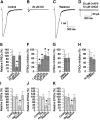



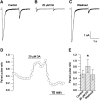
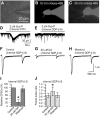
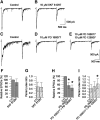
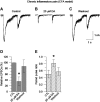
Similar articles
-
Presynaptic inhibition of transient receptor potential vanilloid type 1 (TRPV1) receptors by noradrenaline in nociceptive neurons.J Physiol. 2017 Apr 15;595(8):2639-2660. doi: 10.1113/JP273455. Epub 2017 Feb 22. J Physiol. 2017. PMID: 28094445 Free PMC article.
-
Endogenous transient receptor potential ankyrin 1 and vanilloid 1 activity potentiates glutamatergic input to spinal lamina I neurons in inflammatory pain.J Neurochem. 2019 May;149(3):381-398. doi: 10.1111/jnc.14677. Epub 2019 Mar 26. J Neurochem. 2019. PMID: 30716174 Free PMC article.
-
Multiple targets of μ-opioid receptor-mediated presynaptic inhibition at primary afferent Aδ- and C-fibers.J Neurosci. 2011 Jan 26;31(4):1313-22. doi: 10.1523/JNEUROSCI.4060-10.2011. J Neurosci. 2011. PMID: 21273416 Free PMC article.
-
Presynaptic inhibition of nociceptive neurotransmission by somatosensory neuron-secreted suppressors.Sci China Life Sci. 2017 Sep;60(9):1013-1018. doi: 10.1007/s11427-017-9061-y. Epub 2017 Jun 15. Sci China Life Sci. 2017. PMID: 28624955 Review.
-
Spinal presynaptic inhibition in pain control.Neuroscience. 2014 Dec 26;283:95-106. doi: 10.1016/j.neuroscience.2014.09.032. Epub 2014 Sep 22. Neuroscience. 2014. PMID: 25255936 Review.
Cited by
-
Spinal Cord Injury Alters Spinal Shox2 Interneurons by Enhancing Excitatory Synaptic Input and Serotonergic Modulation While Maintaining Intrinsic Properties in Mouse.J Neurosci. 2021 Jul 7;41(27):5833-5848. doi: 10.1523/JNEUROSCI.1576-20.2021. J Neurosci. 2021. PMID: 34006587 Free PMC article.
-
D1/D5 Dopamine Receptors and mGluR5 Jointly Enable Non-Hebbian Long-Term Potentiation at Sensory Synapses onto Lamina I Spinoparabrachial Neurons.J Neurosci. 2022 Jan 19;42(3):350-361. doi: 10.1523/JNEUROSCI.1793-21.2021. Epub 2021 Nov 23. J Neurosci. 2022. PMID: 34815314 Free PMC article.
-
Methylphenidate and Morphine Combination Therapy in a Rat Model of Chronic Pain.Anesth Analg. 2020 Feb;130(2):518-524. doi: 10.1213/ANE.0000000000004273. Anesth Analg. 2020. PMID: 31206430 Free PMC article.
-
The hypothalamic-spinal dopaminergic system: a target for pain modulation.Neural Regen Res. 2019 Jun;14(6):925-930. doi: 10.4103/1673-5374.250567. Neural Regen Res. 2019. PMID: 30761995 Free PMC article. Review.
-
Projection Neuron Axon Collaterals in the Dorsal Horn: Placing a New Player in Spinal Cord Pain Processing.Front Physiol. 2020 Dec 21;11:560802. doi: 10.3389/fphys.2020.560802. eCollection 2020. Front Physiol. 2020. PMID: 33408637 Free PMC article. Review.
References
-
- Almanza A, Simón-Arceo K, Coffeen U, Fuentes-García R, Contreras B, Pellicer F, Mercado F (2015) A D2-like receptor family agonist produces analgesia in mechanonociception but not in thermonociception at the spinal cord level in rats. Pharmacol Biochem Behav 137:119–125. 10.1016/j.pbb.2015.08.013 - DOI - PubMed
Publication types
MeSH terms
Substances
LinkOut - more resources
Full Text Sources
Other Literature Sources
